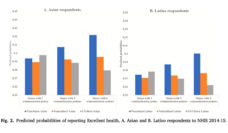Over ten years ago, the Deferred Action for Childhood Arrivals (DACA) program was announced via a memorandum issued by the Department of Homeland Security under the Obama Administration. Since then, the DACA program has provided temporary protection from deportation and work permits to individuals who arrived in the U.S. as children and were undocumented at the time of the program’s passage. DACA eligibility came with other criteria, including being currently enrolled as a student, enlisted in the military, or having completed high school or a GED; the absence of a felony conviction or more than 2 misdemeanors; and having been born on or after June 15, 1981.
Data collected in the aftermath of DACA suggested improved economic outcomes, and better access to health care services for eligible individuals. Studies have also shown positive consequences for the overall health of recipients, potentially driven by lower levels of stress related to the potential for deportation, lower financial strain, and improved opportunities for preventive health care.
Despite this foundational work on the wide reach of DACA’s impacts, we know less about how the program may have rippled out to influence the health of recipient’s family members, including birth outcomes for their newborn children. Birth outcomes are often considered a harbinger of overall population health and can have lasting consequences across the life course.
DACA was associated with modest improvements in birthweight-related outcomes in the years immediately following the policy’s implementation in 2012.
To fill this gap, our research team analyzed birth records from California – the state with the largest proportion of DACA recipients – collected from the years leading up to and the years following DACA passage. We used proxy measures of DACA eligibility based on mothers’ birthdate, birthplace, and educational attainment and insurance status.
We found that DACA was associated with modest improvements in birthweight-related outcomes in the years immediately following the policy’s implementation in 2012. These gains included higher birthweight and a lower risk of infants born small-for-gestational age, particularly for individuals born in Mexico and who were covered by California’s Medicaid program (Medi-Cal). This is important because this subgroup (i.e. born in Mexico and covered by Medi-Cal) may have been more likely to have been DACA recipients. Notably, the majority of DACA recipients were born in Mexico. In addition, those covered by Medi-Cal may have included a higher proportion of undocumented individuals (both those eligible and ineligible for DACA).
However, our results also suggested that the benefits of DACA for population-level birth outcomes in California may have been short-lived. DACA was directly challenged by the Trump administration, placing beneficiaries and future applicants into a state of uncertainty and fear. In fact, rescinding DACA was such a cornerstone of the Trump presidency that he announced he would end the program when he announced his candidacy in June 2015. He rescinded the program in September 2017.
When we extended our analysis to include births between June 2015 and June 2018, we found that the modest but critically important benefits of DACA for birthweight outcomes in California had diminished. This made sense given that the mechanisms likely driving many of the overall health benefits, such as reduced fear of deportation and uncertainty about the future, were reinstated by the direct threats to DACA protection.
The DACA program was eventually upheld by the Supreme Court in 2020, and the Biden Administration has reinstated a commitment to protect DACA recipients. Nevertheless, the program remains without Congressional protection. It is critical to continue monitoring the population health impacts of DACA, including the potential limits of its protective effect on health outcomes amidst direct threats to the program’s future.
Photo via Getty Images















